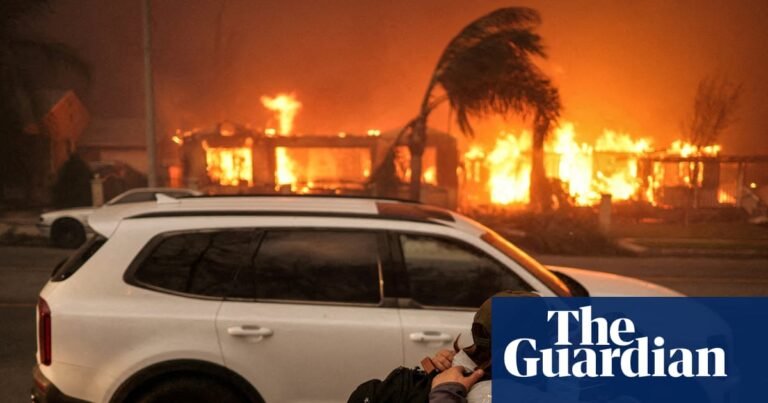New research looking at the aftermath of some of the deadliest wildfires to have struck the US in recent years has shed light on the devastating effects the disasters have on human health, with impacts that extend far beyond the official death toll and injury counts.
Three studies published this week examine the long-term fallout from the Maui and Los Angeles wildfires, including depression, suicide and overdose deaths, lung damage, and deaths caused by healthcare disruptions.
The August 2023 Hawaii blazes killed more than 100 people, in what was the deadliest US wildfire in more than a century, and destroyed the town of Lahaina. The fires that tore through the LA communities of Altadena and the Pacific Palisades earlier this year killed 31 people and destroyed more than 18,000 structures.
Some of the new research found that the Maui fire left one in five people with lung damage, and as many as half with symptoms of depression.
That study, co-led by Ruben Juarez of the University of Hawaii, looked at more than 1,100 adults six to 14 months after the Maui fire. It found lower lung function in people in areas close to the fire compared with those in lower-exposure areas, with about 22% experiencing below-normal lung function.
Additionally, about 40% of people reported their health had declined since the fires, according to the study, and close to half mentioned increased fatigue and weakness, eye irritation and lung-related symptoms.
“It’s a stark reminder that wildfires can leave an invisible but lasting scar on respiratory health, long after the flames are gone,” Juarez told the Associated Press in an email.
During the month of the fire, 13 suicides were reported in the area, nearly double the normal suicide and overdose death rates, another study found.
The study of the Los Angeles fires, led by researchers in Finland, concluded that in addition to at least 30 deaths attributed to the fire, more than 400 deaths between January and February could be blamed on the event because of interruptions in healthcare and other factors.
Dr Jonathan Patz, a University of Wisconsin environmental public health researcher who was not involved with the research, said the studies add “a really important piece to the understanding of the true health risks from these extreme climatic events”.
As the climate crisis fuels worsening disasters across the US, from flooding to deadly wildfires, scientists are trying to gain a better understanding of the impacts of extreme weather events. Research into the effects of wildfire smoke has surged in recent years as massive blazes have caused orange skies and unhealthy air for millions of people from the west coast to New York.
A 2021 study found that breathing wildfire smoke during pregnancy raises the risk of premature birth. Research published earlier this year found the climate crisis contributed to about 15,000 deaths from exposure to small particulate matter from wildfires and cost about $160bn between 2006 and 2020. Another study, published in 2024, determined that wildfire smoke prematurely killed more than 50,000 people in California over a decade.
Kristie Ebi of the University of Washington noted that there is a growing understanding that wildfire smoke can be more toxic than standard air pollution.
“It’s not just leaves and branches and trees” that are burned, she said. “It’s buildings. It’s gasoline stations. It’s old houses that have asbestos in them. It’s automobiles. There are lots of components of wildfire smoke.”
She said the study of the Maui fire suggests “this toxicity is affecting people’s long-term lung function”, but noted more research is needed to look at cause and effect.
Meanwhile, the research calculating rates of suicide and overdose deaths in Maui and Hawaii’s four other counties found a 97% increase in both on Maui during the month of the wildfires. The total number of suicide and overdose deaths was 13 that month, most of them suicides. That’s a significant increase, Ebi said.
They also found a 46% increase in such deaths in all five counties, which may have been influenced by displaced Maui residents migrating to other islands, the authors said. But rates fell in the following months.
In addition to the studies published this week, a new report from the University of Hawaiʻi Economic Research Organization (UHERO), which is based on nearly a year of data from surveys of 950 people, documented the challenges that persist for those affected by the Maui fire. Two years later, some have found permanent housing and greater economic stability, but many people are still displaced and have faced long-term income loss and high rent burdens.
While permanent housing is increasing, poverty rates in the region have almost doubled as full-time employment has not yet fully returned to pre-fire levels and nearly 60% of households report lower income.
“Our findings show two realities unfolding side by side,” said Daniela Bond-Smith, a UHERO research economist. “Some households are finding new footing – moving into stable housing, returning to work and regaining stability. But others are still living with deep uncertainty, especially those with limited support and population groups who had already been marginalized prior to the fires.”
